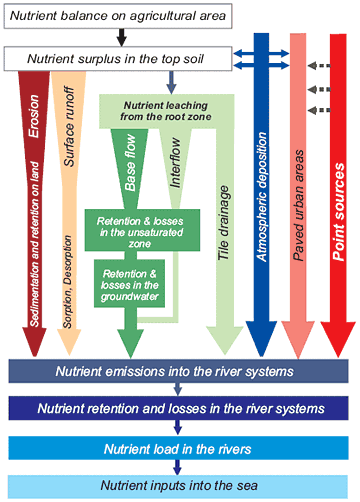MONERIS
- MOdelling Nutrient Emissions in RIver Systems
The Institute of Freshwater Ecology and Inland Fisheries of Leibniz, Germany, is compiling a harmonised inventory for point and diffuse sources of pollution. The model MONERIS (MOdelling Nutrient Emissions in RIver Systems) has been developed and applied in the Danube River Basin to estimate nutrient emissions into surface waters from point and various diffuse sources. The total nutrient input into the Danube River Basin amounts to 61,000 tP/a and 686,000 tN/a.
While point source emissions from wastewater treatment plants and industrial sources are discharged directly into the rivers, the diffuse source emissions that end up in surface waters have many different pathways (point sources: waste water treatment plants and industry; diffuse sources: overland flow, ground water flow, tile drainage, erosion, urban systems and atmospheric deposition).
About half of the nutrients discharged into the river are from agricultural sources, a quarter from industrial sources, and a similar proportion from settlements. The main pollution sources in addition to industrial and municipal wastewater include chemical fertilisers and manure from intensive farming operations, petrochemical processing plants, iron and metal processing plants, timber, paper and pulp plants, and municipal solid waste disposal sites.
The MONERIS approach
The application of the MONERIS (MOdelling Nutrient Emissions into RIver Systems) approach was successfully for the modeling of the nutrient inputs within the Danube River Basin. MONERIS is a semi-static emission model for point and diffuse sources of nutrients can also be adapted in order to deal also with heavy metals and some priority substances (e.g. Lindane).
Conceptually, MONERIS calculates the emissions into surface waters via several independent pathways for separate catchments, which are topologically linked in a tree-like structure (see figure below). Input data are taken from various sources (e.g. statistical yearbooks, emission inventories, digital maps etc). Those data were preprocessed to give specific values for every catchment.
For MONERIS a harmonized database was established for all Danube countries. Results have been used in the Roof Report 2004 for the assessment of point and diffuse nutrient inputs into the Danube River Baisn.

Disclaimer
The information contained in the ICPDR website is intended to enhance public access to information about the ICPDR and the Danube River. The information is correct to the best of the knowledge of the ICPDR Secretariat. If errors are brought to our attention we will try to correct them.
The ICPDR, expert group members, nor other parties involved in preparation of information contained on this website cannot, however, be held responsible for the correctness and validity of the data and information provided, nor accept responsibility or liability for damages or losses arising directly or indirectly from the use of the information conveyed therein.
Only those documents clearly marked ICPDR documents reflect the position of the ICPDR.
Any links to other websites are provided for your convenience only. The ICPDR does not accept any responsibility for the accuracy, availability, or appropriateness to the user's purposes, of any information or services on any other website.
When using the information and material provided on this website, credit should be given to the ICPDR.

